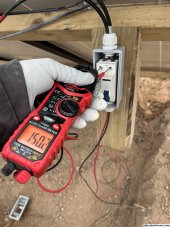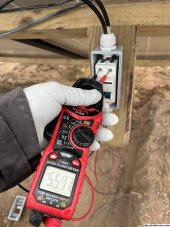MartyByrde
Off-Grid Innovator
Hi,
I am using DC circuit breakers for the first time and I’m having some confusion about the voltage. I have 12 250 W used solar panels from santan solar wired in series. It was a cloudy day and they were measuring around 150-230 V with the DC circuit breaker switched off. It’s my understanding that this would be the VOC. When I switched the breaker on the voltage dropped to 40-50V.
My inverter has a PV MPPT voltage range of 120–550 VDC. I haven’t connected it to batteries yet and it wouldn’t turn on today from just that 12 string of panels.
Is there something wrong with the DC circuit breaker for the voltage to drop down that low, or the voltage wasn’t high enough to meet my inverters minimum requirement?
Lastly, when I turned the DC circuit breaker on and held the multimeter on it for a about a minute it seemed to almost be “charging up“. The voltage began to rise gradually from a lower number and just kept climbing. I’ve never seen this before. Any thoughts?
I have yet to ground the panels to the grounding rod, but just wanted to get the inverter up and running to make sure it works.

I am using DC circuit breakers for the first time and I’m having some confusion about the voltage. I have 12 250 W used solar panels from santan solar wired in series. It was a cloudy day and they were measuring around 150-230 V with the DC circuit breaker switched off. It’s my understanding that this would be the VOC. When I switched the breaker on the voltage dropped to 40-50V.
My inverter has a PV MPPT voltage range of 120–550 VDC. I haven’t connected it to batteries yet and it wouldn’t turn on today from just that 12 string of panels.
Is there something wrong with the DC circuit breaker for the voltage to drop down that low, or the voltage wasn’t high enough to meet my inverters minimum requirement?
Lastly, when I turned the DC circuit breaker on and held the multimeter on it for a about a minute it seemed to almost be “charging up“. The voltage began to rise gradually from a lower number and just kept climbing. I’ve never seen this before. Any thoughts?
I have yet to ground the panels to the grounding rod, but just wanted to get the inverter up and running to make sure it works.




